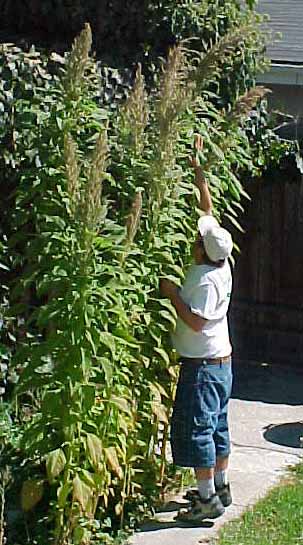
Those plants are Amerinth, which was a staple to the Incas, a lot the way corn is for many of us. Seymore Light, the guy who took this picture, told me something about it. Unfortunately, the first time the Catholics heard about the stuff, it was cooked up with a human sacrifice. They decided it was an evil plant, and took many steps over a long period to demonize it. Much of it is edible, including the roots, leaves and whatever those stalks of flowers at the top are going to develop into. Judging by what I can see, you get a lot of edible food out of one plant with it. Seymore thinks they just had it in that sacrificial dish because they put it in everything. It would probably be a major food source now for a lot of people except for that one historical accident.
I still haven't tasted the stuff.
Tian
Dr. Rufo knows more about Amaranth than most people
I asked him:
>
> How do you tell when amarinth plants are ready to harvest?
>
He replied:
Tian,
This is even more easy: Walk over to one of the plants. Say
something like, "Hi. How's it going there?" Gently take the head in
one hand and "tap" it gently into the palm of your other hand. (Be
sure you have two hands available for this.) If you get a *bunch* of
seeds in your palm, it's time to harvest (usually about 70 days after
planting). No seeds yet? Wait a couple of days and try this again.
If you're not polite, the seeds may never fall into your clutches.
Tell me which recipe you try and the results.
Pax,
Dr. Rufo
(I forgot another easy way to use the seeds: After you toast them in
the oven, sprinkle them over a green mixed salad for "Aztec crunchies.")
Here are some of his recipies for Amarinth cooking:
>Tian,
> You *do* need instructions. You're not supposed to eat the
>*whole* head -- just the seeds !!! If you gently remove them -- put
>the head inside a plastic baggie, close it and shake it, you will
>remove most of the seeds from their pods. The seeds can then be cooked
>in a variety of ways.
>1. Spread them on a baking sheet (aka "cookie sheet") and toast them
>in the oven @ about 325 degrees F for about 5 minutes. Then stir them
>up and repeat for another 7 minutes. Take them out and put them in a
>bowl. Add a bit of butter/margarine/olive oil & some salt & pepper.
>Let them cool off a bit and munch away. This is "Aztec popcorn."
>OR:
>2. Once you have removed them from the amaranth head, put them in a
>sauce pan over a "medium" fire (a "thick-walled" pan is best, if you
>have it, because you want to cook *this* slowly) add a bit of milk and
>stir them into a sort of porridge (most Americans would call this a
>type of "oatmeal" or "farina"). When it's thickened you can add a bit
>of honey and butter and eat away.
>
>There are other recipes (for flour and breads) but they require rather
>large quantities of the amaranth seeds and they're not always easy to
>get in "bulk." Try either of these easy ones first and see if you like
>the taste any better. Don't be discouraged. Oatmeal and farina
>("cream of wheat") both have more flavour than amaranth. Ditto, ditto
>popcorn made with "maize."
>
>Dr. Rufo